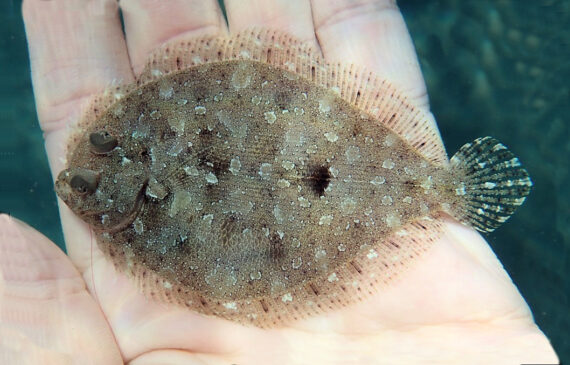Eyed Flounder, Bothus ocellatus
 Eyed Flounder, Bothus ocellatus. Fish caught from coastal waters off Broward County, Florida, August 2021. Length: 10.2 cm (4.0 inches). Catch, photograph and identification courtesy of Ben Cantrell, Sebastian, Florida.
Eyed Flounder, Bothus ocellatus. Fish caught from coastal waters off Broward County, Florida, August 2021. Length: 10.2 cm (4.0 inches). Catch, photograph and identification courtesy of Ben Cantrell, Sebastian, Florida.
The Eyed Flounder, Bothus ocellatus, is a member of the Lefteye Flounder or Bothidae Family, that is known in Mexico as chueco playón. Globally, there are eighteen species in the genus Bothus, of which six are found in Mexican waters, four in the Atlantic Ocean and two in the Pacific Ocean. All family members are left eyed fish with an arched lateral line.
The Eyed Flounder has a deep oval body that is laterally flattened with a depth that is 61% to 67% of standard length with a front profile that has a distinct notch before the lower eye. They vary in color being dark brown to whiteish with three large dark pronounced spots and blotches along the straight portion of the lateral line and an ocellus on the eyed side and pale on the blind side. Their caudal fin lacks large spots and if present they are stacked one on top of the other. They have the ability to change colors quickly to blend into their backgrounds. They have a protractile asymmetrical, downturned mouth with the upper jaw extending posteriorly to or slightly beyond the anterior margin of the lower eye. Their teeth are small and sharply pointed set in two rows. Males have a spine at the tip of the snout and a bony protuberance above the lower eye. Both eyes have a fleshy ridge above and behind them. The lower eye is anterior to the upper eye and the space between the eyes is wide and flat. Their anal fin has 58 to 69 rays and is long and separated from the caudal fin; their caudal fin is broadly rounded; their dorsal fin has 76 to 91 rays and is long and originates above the upper eye and is separated from the caudal fin; their eyed-side pectoral fin as 8 to 10 rays and is elongated in males; and, their blind side pelvic fin originates under the lower eye. They have 8 to 10 gill rakers on the lower arch. The lateral line is only visible on the eye side and is strongly arched above the pectoral fin. They are covered with scales.
The Eyed Flounder can be easily confused with the Mottled Flounder, Bothus maculiferus (body depth 50 to 55%; blue and gold rings on the body; only found along the east coast of the Yucatán in the Caribbean), and the Twospot Flounder, Bothus robinsi (caudal fin with two spots with one anterior to the other; darker with less pronounced spotting and mottling).
The Eyed Flounder is a demersal species that is typically found half buried in sandy substrate near patch reefs within coral rubble or seagrass beds in shallow coastal waters. They reach a maximum of 18 cm (7.1 inches) in length. They are found at depths up to 110 m (360 feet). They are lie-in-wait active daytime ambush predators that feed on crustaceans, polychaetes and mollusks. In turn they are preyed upon by both invertebrates and vertebrates. Their eggs and larvae are consumed by ctenophores, fish, jellyfish, shrimp, and worms as-well-as by birds including egrets, gulls and herons. Juveniles are preyed upon by crabs, fish, and shrimp. Adults are preyed upon by a wide variety of fishes including eels, groupers, the recently introduced highly invasive Red Lionfish, Pterois volitrans, rays, skates and sharks as-well-as seals and sea lions. Reproduction occurs in harems of one male and up to six females with external fertilization and are a daily event over an extended period. Their larvae are pelagic. The Eyed Flounder is poorly studied with very limited information available about their lifestyle and behavioral patterns including specific details on age, growth, longevity, movement patterns, diet, habitat use, and reproduction.
The Eyed Flounder is a resident of all Mexican waters of the Atlantic Ocean including the Gulf of Mexico and the east coast of the Yucatán Peninsula in the Caribbean.
From a conservation perspective the Eyed Flounder is currently considered to be of Least Concern with a stable, widely distributed population. They are small in stature and of limited interest to most. They are also a by-catch of shrimp trawlers and considered to be a pest as the fowl the nets.